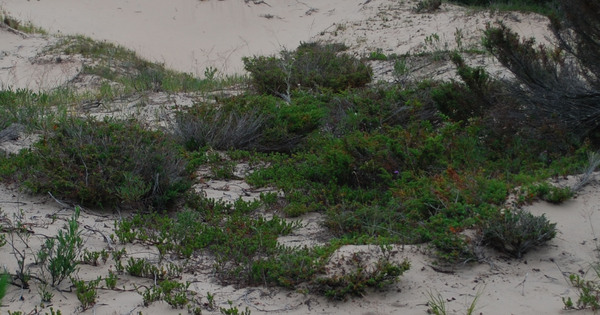Ann Arbor Native - Ground Juniper: The conifer that is almost last, and definitely least (in stature)

Ground juniper (Juniperus communis var. depressa) in one of its favorite habitats, a Great Lakes dune.
Rick Meader | Contributor
We started off with the king, Eastern White Pine (Pinus strobus), then we worked down the chain to Arborvitae (Thuja occidentalis) and Eastern Redcedar (Juniperus virginiana), and last time talked about the charmingly balding conifer, the Tamarack (Larix laricina). This week we move almost all the way down to the ground to find the diminutive, evergreen conifer, the Ground Juniper (Juniperus communis var. depressa).
Not one to take life lying down, it still rarely gets more than three feet tall, but may slowly spread to widths of 10 feet or more wide, with upswept branches. It’s a spiky little thing, with short, awl-shaped needles reaching about ½ to one inch long in whorls of three that are persistent throughout the year. Like its cousin the Eastern Redcedar, its foliage changes from green to brown/maroon in the fall. If you look at the needles closely, you’ll see a white band along the needle. That is a band of stomates, which are structures in plants that facilitate air exchange while helping to regulate the plant’s internal moisture. When it fruits, it forms dark blue, fleshy seed cones that are a crowd-pleaser among songbirds and small mammals that eat them and spread the seeds via their digestive system.
The preferred habitat of ground juniper is definitely not preferred by many other species. They live in dunes, in dry old fields and on rocky outcroppings with plenty of sun. If you have such a habitat in your yard, and you crave low-growing evergreens, this is the plant for you. If you don’t, you should probably go elsewhere for your evergreen. According to the USDA plant website, it is native to southern Michigan and Washtenaw County, as well as most of North America.
According to the University of Michigan-Dearborn Ethnobotany website, it’s not just wildlife that makes use of this plant. They list 143 different uses attributed to this plant by a number of tribes. The seed cones are edible to humans (I don’t know what they taste like), and Native Americans used decoctions and infusions of various parts of the plant for cold and stomach remedies, lung maladies, venereal diseases and a variety of other health issues. In addition, it was burned for incense. In Cheyenne ceremonies it was used to combat the fear of thunder and they burned its leaves to help with child delivery. Since it never gets very big, its lumber isn’t terribly useful.
Well, it was a short one, but I hope you enjoyed learning something about this diminuitive, widely spread evergreen native. Get out and enjoy nature everyone!
Rick is a local landscape architect with a special interest in all things natural, including native plants and the critters that eat them. You can contact him at yourland1824@gmail.com.

